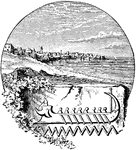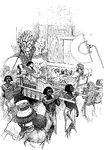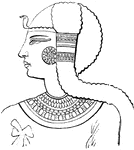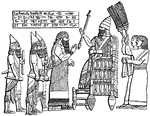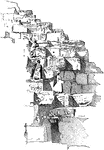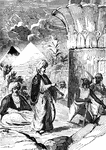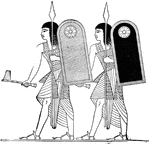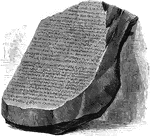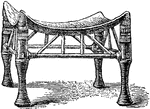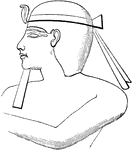The Miscellaneous Egyptian Illustrations ClipArt gallery offers 140 images of general Egypt topics, including many cultural aspects, hieroglyphics, famous persons, and activities of everyday Egyptian life.
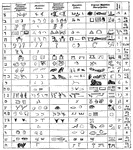
Hieroglyphics vs Ancient Language
A comparative table of hieroglyphics and ancient alphabet characters.

Egyptian hunter
"Hounds were also used to pursue game, as may be perceived from the subjoined representation of a huntsman…

Egyptian Hunting Party
"The hunting scenes are very numerous among their paintings, and the devices for capturing birds and…

The Judgment of the Dead
"Showing the weighing of the heart of the deceased in the scales of truth."—Myers, 1904
Egyptian Kitchen - Roasting a Goose
"A cook roasting a goose; he holds the spit with one hand, and blows the fire with a fan held in the…

Egyptian Kitchen
"Scene in Egyptian kitchen, showing use of a large rope to support a sort of hanging shelf." -Hill,…

Egyptian Man's Costume
This is an Egyptian Man's costume that was worn by priests during the 5th Dynasty. It shows a man wearing…

Egyptian Man's Costume
This is an Egyptian Man's costume that was typically worn during the 5th Dynasty. It consists of a triangular…
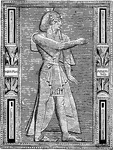
Menepta
Also known as Merneptah. He ruled Egypt as pharaoh for ten years, and was the thirteenth son of Ramessess…

Sarcophagus of Menkera
"The third pyramid on the ridge of Gizeh was built by Menkera, a successor of Khafra and fourth or fifth…

Fruit Gathering Monkeys
"Monkeys appear to have been trained to assist in gathering fruit; and the Egyptians represent them…
Egyptian Needle
"The Egyptian needles were of the following fashion. They wrote with a reed, or rush, many of which…

Nile River
Pheron the king of ancient Egypt is moving an unthinkable amount of soldiers and supplies across the…
Obelisk
An obelisk is a tall, thin, four-sided, monument with a pyramid top. This particular one is inscribed…
Column of Osiris
A column depicting the Egyptian god Osiris. Osiris is usually affiliated with the Afterlife, the underworld…
Plowing and Sowing
A drawing of plowing and sowing in the Pyramid Age of Egypt. The hieroglyphs tell the story of the picture.

Egyptians Plowing
From a Bas-Relief of the Oldest Dynasty, Memphis. Depicts two men plowing with two oxen.
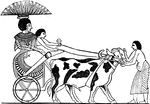
Ethiopian Princess
"An Ethiopian princess on her journey through Upper Egypt to Thebes. The chariot is drawn by oxen, a…

Pschent
A sovereign crown of Egypt, composed of the tall pointed miter, or white crown, of southern Egypt, combined…

Egyptian Rope Making
"Reproduction of sculpture from a tomb in Thebes, showing preparation of leather cords by process similar…
Rosetta Stone
"In 1799, the Rosetta Stone was found and gave the first key to the reading of hieroglyphics. On this…
Excerpt from the Rosetta Stone
"In 1799, the Rosetta Stone was found and gave the first key to the reading of hieroglyphics. On this…

Rosetta Stone Sample
"In 1799, the Rosetta Stone was found and gave the first key to the reading of hieroglyphics. On this…
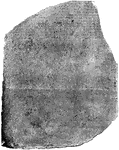
The Rosetta Stone, Front View
A fragment of an Ancient Egyptian text, which provided the key to the modern understanding of Egyptian…

Portion of Rosetta Stone
"In the Nile valley there had been found a few ancient inscriptions, carved upon stone in unknown characters,…
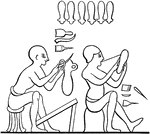
Egyptian Sandal Makers
"The Ancient Sandal Maker as pictured on the wall of the ruined temples at Thebes, Egypt." -Bodmer,…

Ancient Egyptian Sarcophagus
A sarcophagus is a funeral receptacle for a corpse, most commonly carved or cut from stone. The word…
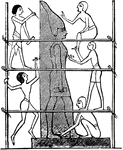
Egyptian Sculptors at Work
"Workmen are represented polishing and painting statues of men, sphinxes, and small figures; and two…
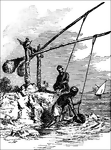
Shadoofs, Two Men Raising Water
"A contrivance extensively employed in Egypt and the East, generally for raising water. It consists…

The Sheikh-El-Beled
"Supposed portrait of one of the overseers of the work on the Great Pyramid. This is one of the masterpieces…

Egyptian Shop
"The Egyptian shops exhibited many curious scenes. Poulters suspended geese and other birds from a pole…

Sphinx
"Sphinx is a Greek word signifying 'strangler,' applied to certain symbolical forms of Egyptian origin,…

Sphinx at Thebes
Nine hundred sphinx's with rams' heads, representing Amon, were built in Thebes, where his cult was…
